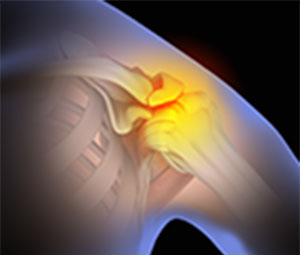Shoulder Impingement

Shoulder Anatomy
The shoulder is a ball-and-socket joint. The ball-shaped end of the upper arm bone (humerus) fits neatly into a socket, called the glenoid, which is part of the shoulder blade or scapula.
What is Shoulder Impingement?
Shoulder impingement is the inflammation of the tendons of the shoulder joint. It is one of the most common causes of pain in the shoulder. Shoulder impingement is also called swimmer’s shoulder, tennis shoulder or rotator cuff tendinitis.
Causes of Shoulder Impingement
Impingement results in the young and middle-aged who engage in physical activities that require repeated overhead arm movements. The pain may be due to bursitis (inflammation of the bursa) overlying the rotator cuff or tendonitis of the cuff itself. In some circumstances, a partial tear of the rotator cuff may cause impingement pain.
Symptoms of Shoulder Impingement
Individuals with shoulder impingement may experience severe pain at rest and during activities, weakness of the arm and difficulty in raising the hand overhead.
Diagnosis of Shoulder Impingement
Diagnosis involves a physical examination by your doctor, where your doctor checks for the possible range of movements with the affected shoulder. X-rays and MRI scans may be ordered to view the injury and inflammation.
Treatment Options for Shoulder Impingement
Conservative Treatment Options for Shoulder Impingement
Shoulder impingement can be treated with rest, ice packs, anti-inflammatory drugs and avoiding activities involving the shoulder. Physical therapy may be advised to strengthen the muscles and steroid injections may be administered if pain persists.
Surgery for Shoulder Impingement
Arthroscopic surgery is recommended if the rotator cuff tendons are torn and to remove the bony spurs.
Exercises for Shoulder Impingement Syndrome
Shoulder impingement syndrome is a common condition seen in athletes and individuals who perform a lot of overhead arm movements. This activity results in irritation of the rotator cuff tendon as it repeatedly rubs against the acromion, which is the bony process of the shoulder blade. Here are some exercises for shoulder impingement syndrome that may help relieve your symptoms:
Scapula Squeeze
Stand with arms at your side and try to squeeze your shoulder blades together. Hold for the position for 5 seconds and then relax. Perform about 10 repetitions.
Scapula Push and Pull
Place your arms out horizontally in front of your body. Extend your arms forward and backward in the horizontal plane by slowly moving your shoulders only. Perform about 10 repetitions.
Chest Stretch
Stand in a doorway and place your forearm on the door frame. Gently turn your body away from the arm until you feel a good stretch in your pectoral muscles. Hold for the position for 5 seconds and then relax. Perform about 10 repetitions.
Front Shoulder Stretch
Stand in a doorway and hold the top of the door frame with one arm. Slowly move forward until you feel a stretch in the front shoulder region. Hold for the position for 5 seconds and then relax. Perform about 10 repetitions.
Back Shoulder Stretch
Place one arm across your body and use your other arm to pull it tightly towards your chest until you feel a gentle stretch of the muscles at the back of the shoulder. Hold for the position for 5 seconds and then relax. Perform about 10 repetitions.
Lying External Rotation
Lie on your side with your affected shoulder on top and the elbow bent at a 90-degree angle. Keeping your elbow at your side, hold a very lightweight in your hand, and slowly rotate your shoulder moving your hand up towards the ceiling. Perform about 10-15 repetitions.
Internal Rotation with Resistance Band
Attach one end of a resistance band to a door handle. Stand sideways to the resistance band and grasp the other end in one hand keeping your elbow bent and at your side. Rotate your shoulder to move your hand across your body without moving the elbow. Perform 10-15 repetitions.
Of note, if you have been diagnosed with a shoulder condition, it is best to consult your doctor before incorporating these exercises into your regular workout routine.
Quick Links
- Shoulder Anatomy
- Arthritis of the Shoulder
- Rotator Cuff Tear
- Shoulder Dislocation
- Frozen Shoulder
- Shoulder Instability
- Shoulder Fracture
- Biceps Tendon Rupture
- Shoulder Arthroscopy
- Total Shoulder Replacement
- Reverse Shoulder Replacement
- Shoulder Hemiarthroplasty
- Rotator Cuff Repair
- Shoulder Stabilization





